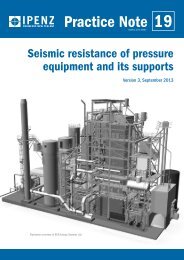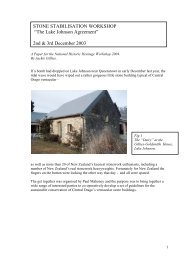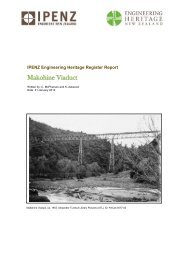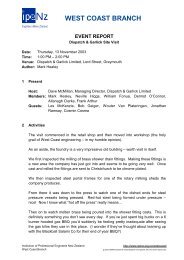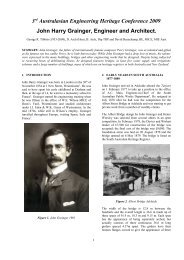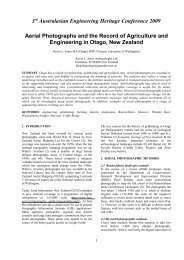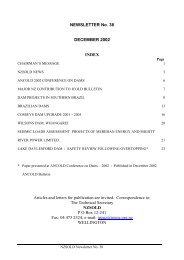Karori Water Supply Dams and Reservoirs Register Report - ipenz
Karori Water Supply Dams and Reservoirs Register Report - ipenz
Karori Water Supply Dams and Reservoirs Register Report - ipenz
You also want an ePaper? Increase the reach of your titles
YUMPU automatically turns print PDFs into web optimized ePapers that Google loves.
Physical narrative<br />
The Lower <strong>and</strong> Upper <strong>Karori</strong> <strong>Dams</strong> <strong>and</strong> <strong>Reservoirs</strong> stretch across the upper<br />
Kaiwharawhara Valley. These form the main components of engineering importance<br />
of the <strong>Karori</strong> <strong>Water</strong> <strong>Supply</strong> <strong>Dams</strong> <strong>and</strong> <strong>Reservoirs</strong>, which were the heart of<br />
Wellington‟s regional water supply system until the late 20 th century.<br />
The dams are each recognised for their engineering significance as early New<br />
Zeal<strong>and</strong> large scale examples of their respective dam types: the Lower <strong>Karori</strong> Dam<br />
being a puddled clay core earth dam <strong>and</strong> the Upper <strong>Karori</strong> Dam is a concrete gravity<br />
dam. The dams <strong>and</strong> reservoirs are individually discussed below.<br />
While buildings <strong>and</strong> the networks of bridges, aqueducts, tunnels <strong>and</strong> pipeline are only<br />
discussed briefly in this section, these are acknowledged as being intrinsic parts of<br />
the <strong>Karori</strong> waterworks‟ former operational effectiveness. For example, generations of<br />
Wellington water engineers modified the functionality at <strong>Karori</strong> as necessity dictated<br />
<strong>and</strong> needs changed, from the late nineteenth century until recently. As a result, an<br />
aspect of the system which is of engineering note was that there were some<br />
extremely complicated pipe intersections, many of which were in tunnels, to allow for<br />
a series of different operational conditions. 61<br />
Lower <strong>Karori</strong> Dam <strong>and</strong> Reservoir<br />
The Lower <strong>Karori</strong> Reservoir is high in Wellington‟s western hills, with a top water level<br />
141 metres (m) above sea level, <strong>and</strong> an original water capacity of 207 million litres. 62<br />
The Lower <strong>Karori</strong> Dam, completed in 1878, “deserves to be described as a l<strong>and</strong>mark<br />
in New Zeal<strong>and</strong>‟s dam-building history.” 63 This earth dam has a central core of<br />
puddled clay, similar to the Ross Creek Dam in Dunedin (1867), <strong>and</strong> rises to a height<br />
of 21.6 m. A puddled clay core dam is one where water was added to the clay <strong>and</strong><br />
then it was compacted into place by ramming. 64<br />
The shoulder material on the upstream side of the puddle clay core was treated<br />
differently to its counterpart in Dunedin. It was graded from fine to coarse as<br />
recommended for British dams after 1852 as the result of the failure of the Bilberry<br />
61 Pers Comm. John Morrison to Karen Astwood, 9 April 2012<br />
62 Cooke, 2008, p.22; Offer, 1997, p.35<br />
63 Offer, 1997, p.37<br />
64 Ibid., p.203<br />
IPENZ Engineering Heritage <strong>Report</strong> 18<br />
<strong>Karori</strong> <strong>Water</strong> <strong>Supply</strong> <strong>Dams</strong> <strong>and</strong> <strong>Reservoirs</strong>



